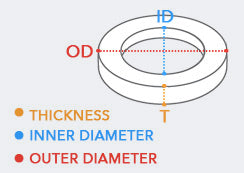Magnetic Product Description:
This Rare Earth ring magnet has an outside diameter of 45mm, an inside diameter of 32mm and a thickness of 12mm. It has a pull force of 22kg. It is identified by the AMF magnet part number 23002.
Uses for our Rare Earth Ring Magnets:
Audio engineers at the helm of sound recording studios rely on neodymium ring magnets like these, 45mm x 32mm x 12mm, to make beautiful music. The quality and applications and the equipment of sound recording has experienced a revolution since 1990’s with the advent of digital sound recording and broadcasting technology.
Formerly with analogue sound recording equipment, magnets were engaged to strictly regulate the movement of the magnetised tape from one reel, over the audio imprinting section, (where the magnetised particles were frozen into patterns able to be interpreted as audio signals or noise), onto another reel for safe storage. The process of magnetisation has played a vital role in the history of recorded sound.
The relationship between sound recordists and magnets continues apace. The highly sophisticated digital electronics equipment of today still employs magnets for the same reasons legacy technologies employed magnets in times past. For capabilities of reliable and durable holding, fixing, releasing and re-engaging, magnets are a connective tissue within electronics equipment without peer.
The clean and reliable capture of sound for the purpose of recording and broadcast is vital. While people may watch less than perfect images or follow confusing stories, people will not tolerate bad sound in broadcast programs.
Sound engineers or professionals recording sound in film and television, like their peers in the past, still rely on magnets and magnetism to capture and safely store recorded sound.
Film and television directors do not simply call ‘action’. Immediately before calling action for the benefit of the actors, the director first calls, ‘Sound’, letting the sound recordist know to start recording the sound for the impending scene. Then ‘Camera’, to let the camera person know to start capturing the images. Only when the director is satisfied the sound is being recorded and camera is recording the images, all with the cheerful assistance many kinds of magnets and magnetism, does he then call his actors to, well, you know the rest of the story from here. Magnets. Is there anything they can’t do?










